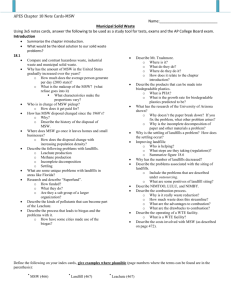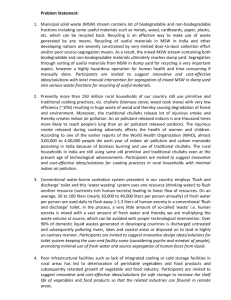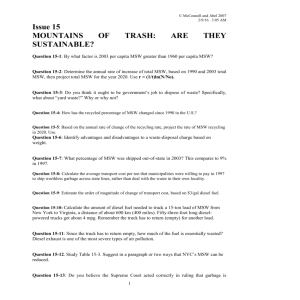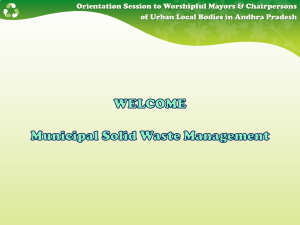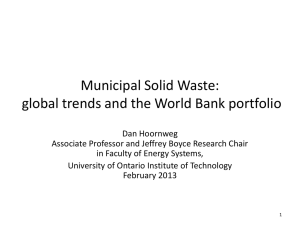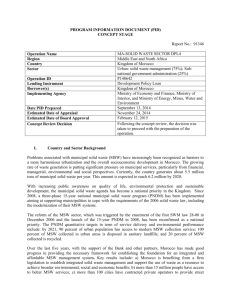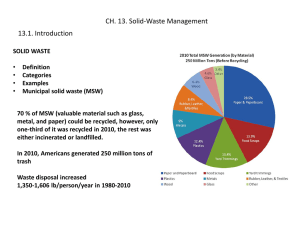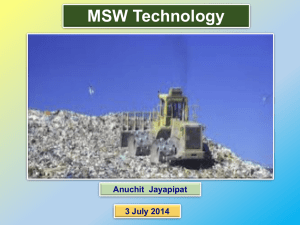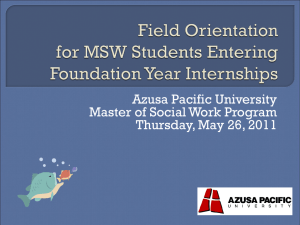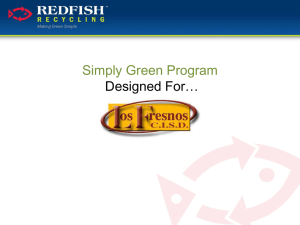WFSC 420 Chapter 19
advertisement
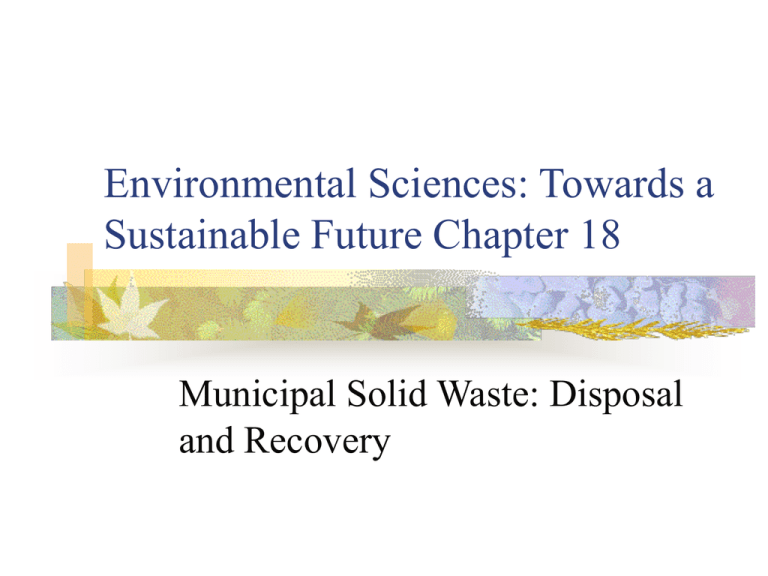
Environmental Sciences: Towards a Sustainable Future Chapter 18 Municipal Solid Waste: Disposal and Recovery Chapter Introduction Danehy Park- Cambridge, MA Danehy Park 50-acre park opened in 1990. Built on a former city dump. Light system in the restrooms to warn of evacuation in the case of methane buildup. Many dumps since the “solid-waste crisis” of 1970s and 80s have been converted to parks, golf courses, and nature preserves. The Solid-Waste Problem Lesson 18.1 MSW MSW=Municipal Solid Wastes The total of all materials from homes or commercial establishments thrown away and collected by local governments. Commonly called trash, refuse, or garbage. Factors Contributing to Increasing Amounts of MSW Factors Contributing to Increasing Amounts of MSW In part by: Increasing populations More so by: Changing lifestyles, increased use of disposable materials*, excessive packaging* * = two largest contributors to waste volume Compare the numbers: 1960 the nation generated 2.7 pounds of MSW per person per day. 2003 the nation generated 4.5 pounds per person per day. MSW Patterns of Disposal US 1998: 55% disposed in landfills, 28% recovered for recycling and composting, 17% combusted. US 2003: 55.4% landfills, 30.6% recycling, 14% combustion. Over the past 10 years, the overall trend is landfill and combustion declining, recycling increasing. Pattern not the same for highly populated areas like Japan (combusts 75%) and Western Europe (0ver 50%). US: MSW Components The US Fate of MSW Landfills: waste put on or in the ground and covered with earth. Problems with old landfill structures. Leachate generation Methane production Incomplete decomposition Settling Leachate Generation As water percolates through the refuse and ground, it carries contaminates with it to ground water. Florida: Superfund helped to get landfills state-of-the-art liners to prevent ground water contamination Much of the land is flat, only a few feet above sea level and rests on watersaturated limestone…big problem. Methane Production Natural Decomposition. Buried wastes are anaerobicaly broken down by detritus feeders creating biogas. Gases seeping to the surface kill vegetation, leading to erosion that exposes the unsightly wastes. Biogas Exploitation 390 commercial landfill gas facilities in the US California has the largest facility 1998: produced 108 trillion BTU’s of energy=20 million barrels of oil. 2005: produced 9 billion kWh of electricity. Riverview, Michigan The city collaborates with DTE to “mine” the landfill gas under the 212acre landfill (Mt. Trashmore). Provides 3700 homes with energy. Doubles as a ski and recreation area during winter months. Incomplete decomposition Materials don’t completely break down. Paper makes up 35% of the MSW. If paper is recycled, it won’t become MSW. 30 year old papers have been recovered (readable). Settling Building not built on landfills because of settling. Causes a problem for playgrounds, golf courses that are converted landfills because it creates shallow depressions (or even deep holes) that hold water and seeps into ground water. EPA: Improving Landfills Upgraded siting and construction regulations. Sited on high ground. Floor contoured. Layering of materials, leachate draining system, and liners. Ground water monitoring. Siting: Public Reactions LULU (locally unwanted landuse) NIMBY (not in my backyard) NIMTOO (not in my term of office) Siting Problems Drives up the cost of waste disposal. Leads to inefficient and equally objectionable practice of long-distance transfer. Table 18-1 p 470. Advantages of Combustion: waste to energy Can reduce weight by 70% and volume by 90%. Toxic/hazardous materials concentrated into two streams for easier handling and control. Generate electricity. No changes needed for collection procedures. 2/3 of combustion facilities are WTE facilities (compliant with clean air act regulations). Resource recovery. Combustion: Drawbacks Health affects: older, poorer managed facilities. Expensive to build. Ash loaded with heavy metals. Must have continuing supply of MSW. Impedes recycling (direct competition for same materials). Waste to Energy facility (Figure 18-7 page 471) Steps to process p.471, #ed. Cost of MSW disposal Tipping fees: $30-$100 per ton. Transportation costs. Increasing expense has lead to illegal dumping. Solutions Lesson 18.2 The Solutions Reduction Recycling Composting Source Reduction Definition: practice of designing, manufacturing, purchasing, or using materials in ways that reduce the amount or toxicity of the trash collected. Waste prevention Accomplishes two goals: Reduces amount of waste to be managed. Conserves resources. Source Reduction in Action Lightening the weight of many items has reduced the amount of materials used. Electronic communication lessens paper load. Durable goods made reusable. Lengthening product life. Get off the bulk mail list Recycling as a Solution More than 75% MSW is recyclable. Primary recycling: original waste material made back into same product. News papers to newsprint Secondary recycling: waste made into a new product. Newspaper to cardboard Recyclable Materials Paper and paperboard Most glass Some forms of plastics Metals Yard wastes Textiles Old tires The Most Successful Recycling Programs No cost to recycle but PAYT for MSW Mandates Make it curbside Goals are ambitious but clear and feasible Efforts made to involve industry Municipality has hired a recycling coordinator “Experience has shown that at least two-thirds of households will recycle if presented with a curbside pickup program” Fact: A one meter stack of newspapers is equal to the amount of pulp from one tree. Plastic Recycling Code 2: HDPE-high density polyethylene. Code 1: PETE-polyethylene terephthalate. Use for recycled plastics is limited somewhat because of contamination in the cross over process. Ex: some may not be reused for food containers. Composting Currently 13% of MSW, becoming more popular as it is banned from MSW collections. End product is a residue of humuslike material. 3800 municipal yard waste composting programs reported in 1998 MRF’s- “murfs” 2001 there were 480 operating in the US. Wastes are sorted and shipped to proper locations for reuse. Public Policy and Waste Management Lesson 18.3 MSW Regulations Solid waste disposal act 1965 Resource recovery act 1970 and1976 Superfund act 1980 Hazardous and solid waste amendments 1984 Integrated Waste Management Different combinations of source reduction, WTE combustion, recycling, recovery facilities, landfills, and composting depending on the options that work best for the region. A system of several alternatives in operation at the same time. Reduce, Reuse, Recycle Recycling is the wave of the future. Should not be the main pursuant in lieu of reduction or reuse Reduction is the most environmental sound. Wastes that are not generated do not need to be managed. Sustainable MSW Management Waste reduction Safe waste disposal Recycling and reuse
